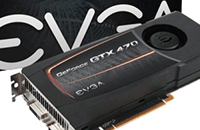The EVGA GTX 470 is available in 4 versions in the American region. If you read the other articles, you’ll notice that EVGA thankfully held back this time. The GTS 250 had 9 versions and the 260 had 15! No more worrying about connectors or onboard memory. For a complete list of each model and explanation of the model numbering system, take a look at the next page.
For this application we had a choice between 3 editions- the standard edition, the Superclocked edition, and the Superclocked+ edition. The FTW version, also known as the ‘GTX 470 Hydro Copper FTW,’ is meant for water cooling applications. The Superclocked GTX 470 versions obviously have higher clock settings than the standard edition. We won’t need the factory to overclock our card because we can handle that ourselves. The Superclocked+ edition comes with an improved backplate and and bracket, which EVGA says can lower your temps by 7°C.
A great feature about this board is that it is the same physical size as the humble GTS 250, yet as strong as an ox. This is thanks to the smallest fabrication process available – 40 nanometers. That length, by the way, is 9.5 inches inside the case (or 10 from the tip of the DVI connector). This card is actually shorter than the GTX 260 Core 216, which used a 55nm process.
New to the GT400 series is a standard HDMI 1.3 connector. These cards drop the older HDTV 7 pin round connector in favor of HDMI 1.3 and it’s digital connnection. The HDMI spec has the ability to carry sound as well as picture, but that is moot when talking about graphics. However, if you prefer to output digital SPDIF sound through a single HDMI cable, you need a small patch cord that goes from the card to the motherboard (your motherboard must support this, obviously). Strangely, the box does not contain said patch cord, and it is not something you would have lying around like SATA cables and power cords.
The final set of differences between these cards is simply the clock frequencies. The GT200 series had different models with 2 sizes of onboard memory, but now the GTX 470 only uses 1,280 MB of GDDR5. The following table contains that relevant data for the entire AR line of GTX 470 cards produced by EVGA.
| Model | Core | Memory | Shader | |
|---|---|---|---|---|
| 012-P3-1470-AR | GTX 470 | 608 | 1674 | 1215 |
| 012-P3-1472-AR | GTX 470 Superclocked | 625 | 1701 | 1250 |
| 012-P3-1475-AR | GTX 470 Superclocked+ | 625 | 1701 | 1250 |
| 012-P3-1479-AR | GTX 470 Hydro Copper FTW | 650 | 1701 | 1300 |











